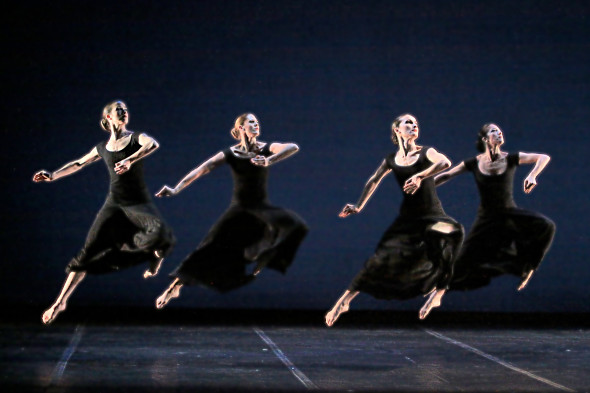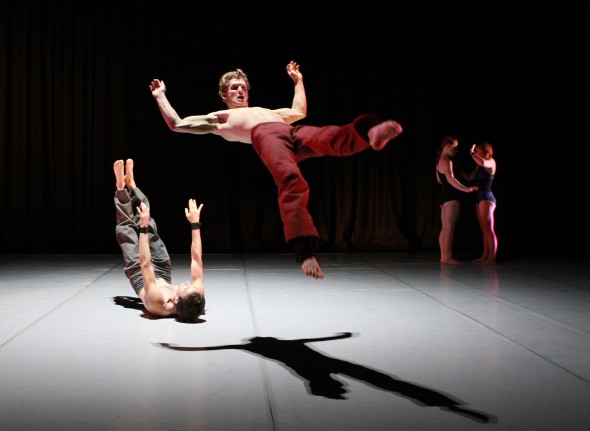Fall For Dance Festival 2012
The choreography of Twyla Tharp and Martha Graham, mixed with the talent of the American Ballet Theater, Juilliard Dance, and The Hong Kong Ballet, all showcased on one stage in one magical evening is probably every dance enthusiast’s dream. A taste from the greats along with a sampling of new, powerhouse companies can only mean one thing – the Fall For Dance Festival at the New York City Center. Celebrating its ninth consecutive year, the Fall For Dance Festival showcased 20 acclaimed dance companies spanning over 12 nights of show-stopping and exceptionally diverse dance performances from tap dance to ballet to modern to circus acrobatics to flamenco! Nothing was lacking and every form was considered. It was a carefully balanced concoction of movement and music that audience members fed on for a three-week run. For my avid readers, you all know that I am a huge fan of Frank Sinatra’s. For those of you new to my writing, you are now aware, and prepare for the swooning and awing of a culmination of one of my favorite musical artists together with one of my favorite contemporary choreographers. The second program of the festival included the American Ballet Theater (ABT) and their principal dancers Luciana Paris and Herman Cornejo performing the Sinatra Suite. Stunning, never-ending lifts by the duo, floating over classics like Strangers in the Night and My Way, were accented by the simple and clean costumes designed by Oscar De La Renta – a basic, black suit for the man and an elegant black shift for the woman. This piece was the prelude to Twyla Tharp’s Broadway production of Come Fly Away: a five-part suite featuring the music of ol’ Blue Eyes and the craft of a choreographer bringing together a tumultuous couple by way of a dance-therapy session. It is beautifully executed, and the Sinatra Suite on its own (I was lucky enough to see Come Fly Away during its short run on Broadway) makes for an entertaining, love-driven vignette that any person in their right mind can sympathize with. And that’s just the storyline – the dancing was impeccable. Tharp’s signature lifts and unconventional partnering drives the suite forward, keeping the relationship struggle a constant.
 In complete contrast, the Martha Graham Dance Company performed the mother of modern dance’s riveting piece, Chronicle. Considered to be Graham’s iconic work, the dynamic music and innovative movement representing the rise in fascism during the mid-1930’s is so eerily premonitory of what was to come within the next 10 years of the piece’s creation. Blakeley White-McGuire, soloist in the three-part ballet, seemed to channel Graham herself in her explosive and forceful movements center stage. It was like watching a creature, dynamic in movement with fits of wild rage followed by controlled, deliberate stances, perfectly foreshadowing the psychosis of the German leader pre-World-War-II. And the army of women, the sheep that followed in the flock blindly, were not only snapshots of mechanical robots obeying orders but were movements and shapes imitating the cubist and avant-garde brush strokes simultaneously happening at that time in art and literature. To me, Graham’s choreography reminds me of moving Picasso paintings: jagged edges with limbs and angles unnatural yet absolutely beautiful.
In complete contrast, the Martha Graham Dance Company performed the mother of modern dance’s riveting piece, Chronicle. Considered to be Graham’s iconic work, the dynamic music and innovative movement representing the rise in fascism during the mid-1930’s is so eerily premonitory of what was to come within the next 10 years of the piece’s creation. Blakeley White-McGuire, soloist in the three-part ballet, seemed to channel Graham herself in her explosive and forceful movements center stage. It was like watching a creature, dynamic in movement with fits of wild rage followed by controlled, deliberate stances, perfectly foreshadowing the psychosis of the German leader pre-World-War-II. And the army of women, the sheep that followed in the flock blindly, were not only snapshots of mechanical robots obeying orders but were movements and shapes imitating the cubist and avant-garde brush strokes simultaneously happening at that time in art and literature. To me, Graham’s choreography reminds me of moving Picasso paintings: jagged edges with limbs and angles unnatural yet absolutely beautiful.
A week following this intense evening of dance greats hosted another program which shot me to the other end of dance greatness. The last program of the festival opened with Shen Wei Dance Arts’ Rite of Spring. The piece embodied the idea of the spring season: a slow beginning, like buds of flowers coming through the cold, damp dirt softening from the end of winter. Much like spring itself, once it is in full bloom, forces of nature’s beauties are abundant and beautiful, and completely full of life. The dancers went from meticulously moving creatures to flowing bodies of energy, imitating movement of a story being written in cursive, the pen never leaving the paper. The fluidity of the choreography and the synchronization and uniformity of the movement was beyond impressive. These dancers became replicas of each other, and not in a way that was boring or uneventful; on the contrary, the fact that these dancers were so well-aligned with each other made them seem even more like animals moving in the forest, keeping to their position in the eco-system as matter-of-fact as possible. It was incredible.
 Anxiety is not my favorite sensation, actually probably one of my least favorite besides physical pain, however Circa’s entire performance thrived off of the uncomfortable energy that the audience endured for their 20 minute set. By no means am I trying to say the performance was bad – it was the complete opposite, but the uneasy feeling of anticipating someone falling on their head and breaking a neck was constant and kept me breathless for all 20 minutes. In a self description, Circa ‘combines amazing circus skills in new and startling configurations, a moving soundtrack, and a muscular and precise movement sensibility.’ That’s right, burly men tossing little gymnasts in badass gunmetal leotards from one end of the stage to the other called for some heart-stopping moments. I would say 20 minutes of heart-stopping moments, and I was holding my breath one too many times. I had never seen anything like it. It was trick after trick after trick with never a dull moment. And it didn’t get old; the next trick would always top the last one, and so on. The girls were a cross between Olympic athlete Shawn Johnson and Goth fictional character Lisbeth Salander. It was so impressive that I was still out of breath even after the 15-minute intermission following Circa had ended.
Anxiety is not my favorite sensation, actually probably one of my least favorite besides physical pain, however Circa’s entire performance thrived off of the uncomfortable energy that the audience endured for their 20 minute set. By no means am I trying to say the performance was bad – it was the complete opposite, but the uneasy feeling of anticipating someone falling on their head and breaking a neck was constant and kept me breathless for all 20 minutes. In a self description, Circa ‘combines amazing circus skills in new and startling configurations, a moving soundtrack, and a muscular and precise movement sensibility.’ That’s right, burly men tossing little gymnasts in badass gunmetal leotards from one end of the stage to the other called for some heart-stopping moments. I would say 20 minutes of heart-stopping moments, and I was holding my breath one too many times. I had never seen anything like it. It was trick after trick after trick with never a dull moment. And it didn’t get old; the next trick would always top the last one, and so on. The girls were a cross between Olympic athlete Shawn Johnson and Goth fictional character Lisbeth Salander. It was so impressive that I was still out of breath even after the 15-minute intermission following Circa had ended.
To end the fifth program was the María Pagés Compañía from Spain, featuring one of my favorite styles of dance to watch, flamenco. Deseo Y Conciencia (Desire & Consequence) was a multi-faceted suite beginning with a clean solo by the artistic director of the company. Pagés was dressed in an atypical flamenco costume: black leggings and a skintight black turtleneck, highlighting her never-ending long legs and branch-like arms and hands that continuously wove an invisible web in time with the live gypsy accompaniment behind her. Following her solo were small vignettes of modern, group flamenco of incredible speed, rhythm, and syncopation by her company of dancers. These dancers’ heartbeats were synchronized, along with their heeled shoes and snapping fingers. More solos followed, along with an impromptu flamenco jam during the standing ovation given by the audience.
Fall For Dance Festival is a time where dance companies from every walk of life share the stage, a rarity especially in a city like New York. The dance community is a competitive one, but these evenings of camaraderie truly embody the idea that dance crosses borders whether they are intermissions or closed curtains.
1. Fall For Dance 2013: Next year marks the 10th anniversary of the Fall For Dance Festival – don’t expect anything less than INCREDIBLE as this will be a momentous event! Stay tuned for 2013!
2. Follow: Want to hear more updates about Fall For Dance and the New York City Center? Be sure to follow @NYCityCenter and #FallForDance on Twitter!
3. New York City Center: One of the premiere theaters for dance and arts in New York City, the City Center offers an array of upcoming performances including the Alvin Ailey American Dance Theater, Nov 28-Dec 30, 2012!
4. LDP: Another impressive company performing at the festival was the Korean-based Laboratory Dance Project (LDP) featuring their award-winning piece No Comment, which they continue to showcase worldwide!
5. Classical ballet: The Hong Kong Ballet wowed audiences with their classical choreography that was filled to the brim with emotion, impeccable technique, and beauty. Be sure to catch an upcoming performance once their international tours commence!

